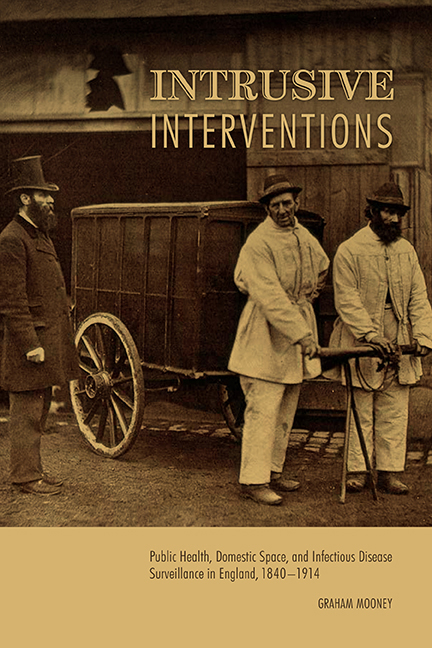 Intrusive Interventions
Intrusive Interventions Book contents
- Frontmatter
- Dedication
- Contents
- Acknowledgments
- Abbreviations
- Introduction
- Part One Making Infectious Disease Surveillance
- Part Two Spaces of Risk and Opportunity
- 3 Sequestration and Permeability: Isolation Hospitals
- 4 “Combustible Material”: Classrooms, Contact Tracing, and Following-Up
- 5 Disinfection, Domestic Space, and the Laboratory
- 6 Rules for Home Living: Tuberculosis and the Consumption of Self-Help
- Conclusion
- Notes
- Bibliography
- Index
6 - Rules for Home Living: Tuberculosis and the Consumption of Self-Help
from Part Two - Spaces of Risk and Opportunity
Published online by Cambridge University Press: 14 March 2018
- Frontmatter
- Dedication
- Contents
- Acknowledgments
- Abbreviations
- Introduction
- Part One Making Infectious Disease Surveillance
- Part Two Spaces of Risk and Opportunity
- 3 Sequestration and Permeability: Isolation Hospitals
- 4 “Combustible Material”: Classrooms, Contact Tracing, and Following-Up
- 5 Disinfection, Domestic Space, and the Laboratory
- 6 Rules for Home Living: Tuberculosis and the Consumption of Self-Help
- Conclusion
- Notes
- Bibliography
- Index
Summary
By the early twentieth century, the aspirations for disinfection that had been expressed by John Simon and others in the 1860s had, to some extent, been realized. A “modern” and scientifically up-to-date program of municipal disinfection in the early 1900s combined formalin spray for houses and steam disinfection for articles and clothes. When using these processes in conjunction with technology that reduced operator error and increased capacity, sanitary authorities—certainly in the big industrial cities, but also in some rural areas that owned mobile apparatus—were as confident as they ever had been that some measure of command could be had over the infectious debris that lurked in working-class homes.
The Manchester experiments with tuberculosis disinfection in the 1890s that were described in the previous chapter were symptomatic of a widespread discussion over how to control a disease that did not readily fit into the “infectious” category and a bacterium whose virulence was uncertain. Although infectivity was asserted in the wake of Koch's discovery of the tuberculosis bacillus, multiple views continued to be held about the proximate causes of tuberculosis and why mortality rates were falling. Michael Worboys stratifies five groups of opinion. “Insanitationists” believed general sanitary improvements were responsible. “Infectionists” emphasized the control of person-to-person spread. “Hygienists” looked to behaviors and lifestyle changes. “Diasthesians” sought to remove people with inherited susceptibilities. For “tubercularisationists,” the development of acquired, herd immunity helped explain reductions in the disease.
This typology is extremely useful for disentangling the strands of argument wrapped up in explanations of tuberculosis incidence and prevalence, though it has to be acknowledged that some individuals held opinions about tuberculosis that cut across these groups, or moved between groups over time. And although Worboys notes that these opinions emerged chronologically, they did not “replace one another in a sequential way.” Worboys also points out that “the views of all the groups were linked to specific TB control policies.” One thing the different groups did have in common, however, was the belief that a policy for the notification of the tuberculosis patient was fundamental to the success of intervention. The Insanitationists in the 1880s, the Infectionists in the 1890s, and the Hygienists in the 1900s were all in favor of notification and disinfection for tuberculosis.
- Type
- Chapter
- Information
- Intrusive InterventionsPublic Health, Domestic Space, and Infectious Disease Surveillance in England, 1840-1914, pp. 154 - 178Publisher: Boydell & BrewerPrint publication year: 2015


